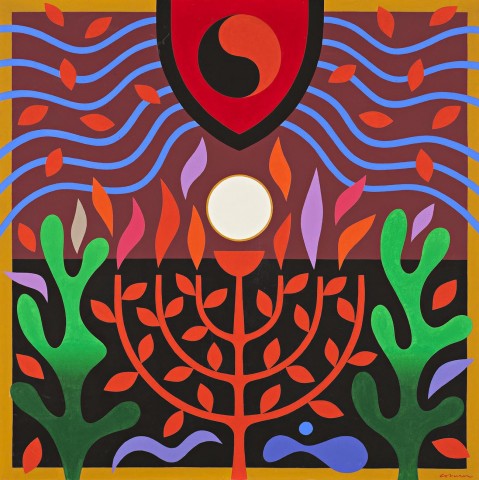TREE OF LIFE VI, 1975
JOHN COBURN
synthetic polymer paint on canvas
152.0 x 152.5 cm
signed lower right: Coburn
signed, dated and inscribed with title verso: TREE OF LIFE VI / JOHN COBURN / SYDNEY 1975
John Marsden AM, Sydney
Thence by descent
Private collection, Sydney
Central Mandala – The Private Collection of John Marsden, Campbelltown City Bicentennial Art Gallery, New South Wales, 15 March – 14 April 1996
On long-term loan to the Campbelltown Arts Centre, New South Wales from 2012
Throughout the 1970s the overarching theme of John Coburn’s work was his religious faith. In fact given the colour and exuberance of his works from this period, they could be considered to be amongst his most vibrant and theatrical works. The paintings are often highlighted with gold or silver paint which imbues them with a precious quality and in some ways, endows the paintings with a sense of the holy. The works are often symmetric in composition, reflecting the art and architecture of Christian places of worship.
As well as his faith, Coburn drew upon nature for his inspiration. Tree of Life, 1975, is a quintessential example of the artist’s celebration of his beliefs, incorporating stylised ecumenical symbolism as the central subject of the work. Within this painting the artist merges two forces; the artist as creator and a higher force as the creator of all things. Alan Rozen sums this up simply, ‘He is constantly aware of the abstraction of a feeling for beauty and achieves his aims by a union of this feeling and beliefs in religion and nature. This then presents a twofold approach by Coburn to his work: first, he wants to produce something that is beautiful and pleasing to look at and, secondly, on a more profound level, he wants to relate his religion to nature, and nature to his religious beliefs.’1
While abstract painting in Sydney from the mid-1970s on, had very much been a lyrical affair, Coburn’s direct application of opaque paint and his personal repertoire of forms became the staple of the artist’s mature style. His broad primordial forms, with their slabs of secondary colour, must have come as a cool antidote to the wristy arabesques of the likes of Passmore, Olsen, Johnson and Whiteley.
Robert Hughes made this prescient observation in a review of an early Coburn exhibition at the Macquarie Galleries in Sydney, ‘Coburn is unlike any other significant Australian non-figurative painter in that his works are deadpan, unmarked by the evidence of struggle which gives other abstracts their peculiar intensity … It may all look effortless and inevitable, as though the problems of painting had given way to those of assembling a jigsaw puzzle. His intuition does not, it seems, unfold itself during the final creative act; everything is thought out beforehand’.2
What he may have lacked in lyricism he compensated for through his astute instinct for colour and design. John Coburn’s popularity has endured and continues to grow steadily as the years pass. Through his many solo exhibitions, important commissions and prestigious awards he has well and truly cemented his place in the canon of Australian painting.
1 Rozen, A., The Art of John Coburn, Ure Smith, Sydney, 1979, p. 10
2 Hughes, R., ‘Coburn Jigsaws’, Nation, Sydney, 19 November 1960
HENRY MULHOLLAND
